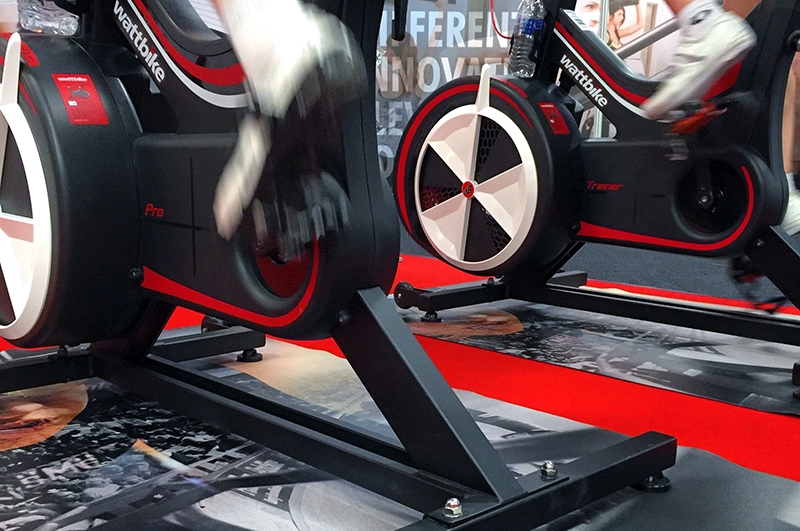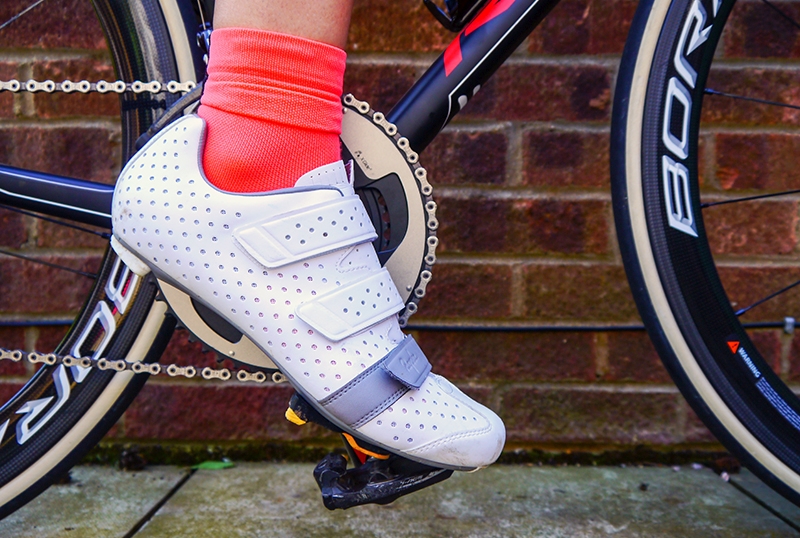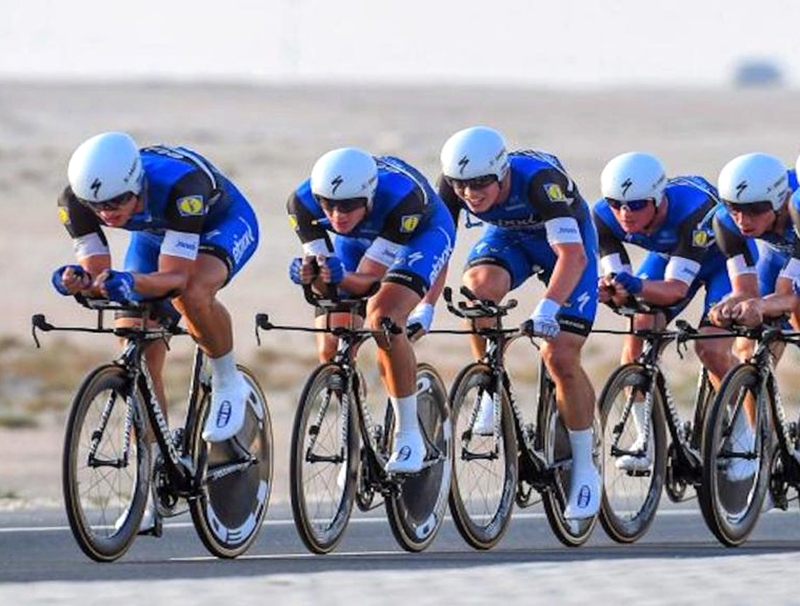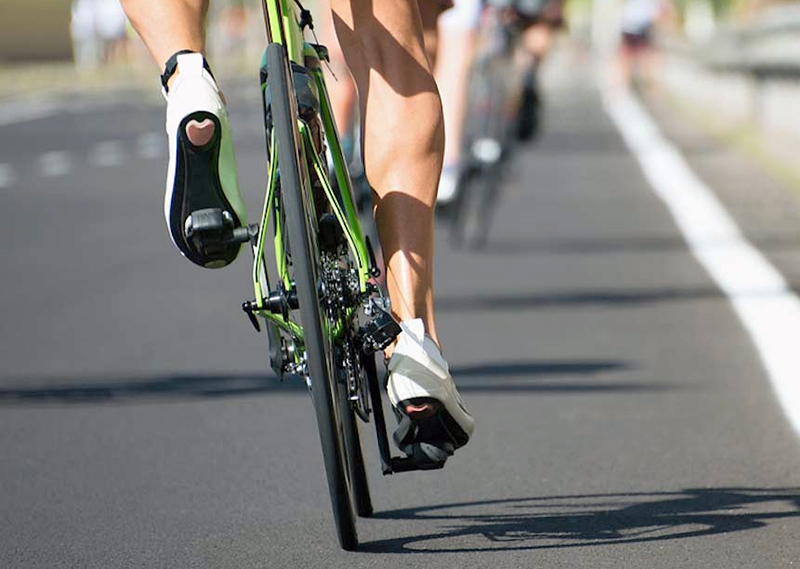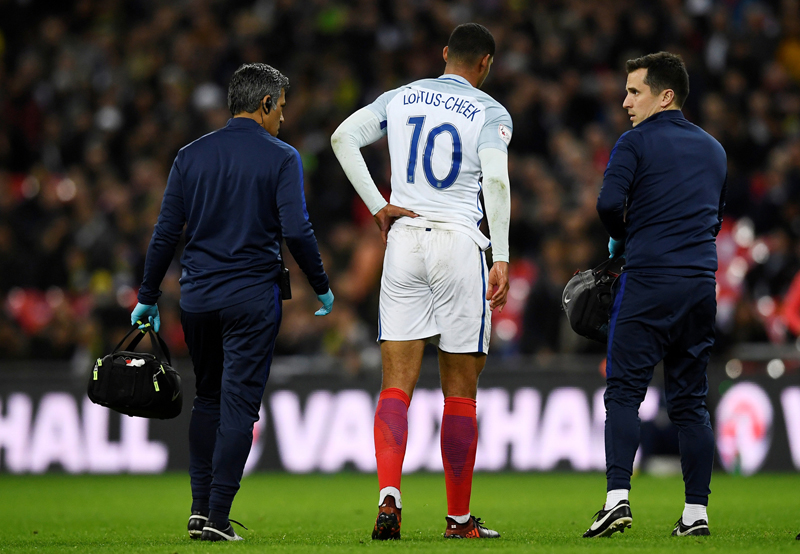You are viewing 1 of your 1 free articles. For unlimited access take a risk-free trial
Cycling injury prevention: take a hands on approach

For most cyclists, the word ‘injury’ normally conjures up images of impacts sustained from collisions or knee and lower back injuries. However, the hand/handlebar interface can lead to chronic problems in the hand and wrist. Andrew Hamilton explains why, and looks at preventative steps
In recent years, the popularity of cycling as a sport and leisure activity has increased dramatically. In particular, participation in so-called ‘sportive’ rides (where riders challenge themselves to complete a long-distance ride - typically over 100kms within a certain time limit) has become very popular, especially among novice riders. The spectrum of participation in cycling has also broadened considerably thanks a general increase in the awareness of the health benefits of exercise and the trickle-down effect of technology, which has made lighter and more advanced bikes far more affordable than ever before. High-mileage cycle training is no longer the exclusive preserve of the race cyclist!Benefits and risks
While cycling offers significant health benefits and offers a low-impact means of exercise, it is not completely without the risk of injury. An obvious risk of injury concerns collision with motor vehicles or other types of collision (eg other cyclists, pedestrians, animals, road debris etc)(1). However, the data also suggests that cyclists are more likely to suffer from injuries resulting from the action of cycling itself, with one study putting the prevalence of non-traumatic injury as high as 85%(2). The research also suggests that the most common sites for non-traumatic cycling-related injuries include the knee, neck/shoulder, hands, buttock and perineum (groin). Moreover, one of the categories of cycling injury that may have the greatest impact on disability is that of ulnar and median nerve palsy – a painful condition resulting from localized pressure at the hand/handlebar interface.Three points of contact
Regardless of the bike type, frame geometry and riding position, all cyclists make contact with the bike at three different points: the pedals, the saddle and the handlebars. At each of these points, forces are generated at the interface of the bike and rider. The greatest forces are those at the pedals, where large forces have to be applied to drive the transmission, and the saddle, where a significant portion of the rider’s weight is perched on a relatively small surface area, resulting in large amounts of force per unit area.Compared to those at the pedals and saddle, the forces experienced by riders at the handlebar interface are significantly less, although they will vary according to the handlebar design, the rider’s position (ie how far forward he or she is leaning), the amount of cushioning between the hands and the bars (padded tape, gloves etc) and - something that is often overlooked - the stiffness of the bars (stiff bars transmit more road vibration to the rider’s hands).
Nearly all road bikes use drop handlebars, which offer three main riding positions: on the bar tops near the stem, on the brake hoods and on the drops. Regardless of the actual drop handlebar design (see figure 1), all drop handlebars offer a key advantage over straight handlebars – the ability to adopt different hand positions and orientations and so distribute the loading more evenly than would otherwise be possible.
Laws of physics
However, riders can’t escape the laws of physics; the further forward and lower the grip on the handlebars, the more of the rider’s weight needs to be supported by the hands and the greater the forces experienced at the handlebar interface. This means for example that the bars of a bike with full-on racing geometry (where the handlebars are relatively low compared to the saddle in order to encourage a fairly horizontal torso and so lessen the effects of wind resistance) will produce significantly larger loadings on the rider’s hands than an ‘Audax’ bike whose bars are positioned higher to promote comfort over long rides. Similarly, on the same bike, holding the drops will produce larger loadings on the hands than riding the tops or hoods.Figure 1: Handlebar design and loading pressure on the hands

Drop handlebars, as used on road or track bikes may have a shallow or deep drop. Deep drop bars allow riders to gain a more ‘aero’ advantage on the drop (by a lower torso position) at the cost of increased loading on the hands. The shape of the drop may be a simple, traditional curve, or it can have a flat spot in the straight section, which some riders find to be more comfortable for their hands. These bars are sometimes described as ‘ergo’ or ‘anatomic’ bars. Another variation in drop bar design is the Audax or Randonneur design. These are bars that rise gently from the center in a shallow ‘U’ shape while the drop portion of the bars is set wider than the curve at the top. Again, although not quite so aerodynamic, the goal is to increase hand comfort during longer rides. The figure above shows a standard drop bar design (on the left) and an Audax design (one the right).
Handlebars and injury
Although there’s comparatively little scientific data from chronic/overuse injuries sustained by riders at the handlebar interface, the studies that have been carried out suggest that these kinds of injury form a significant proportion of rider injuries overall. For example, a 1995 study found that in cyclists reporting chronic overuse injuries, over 31% of the respondents were suffering from hand injuries(3). The most prevalent chronic injury of the hand that can affect cyclists is ulnar and median nerve palsy (also known as ‘handlebar’ or ‘cyclist’s palsy), which as mentioned above, is caused by localized pressure at the hand/handlebar interface(2).Another related (but less common) condition associated with prolonged handlebar loading is carpel tunnel syndrome (see figure 2). A US study looked at 14 cyclists who underwent median and ulnar motor and sensory nerve conductions, performed on both hands before and after a 6-day, 420-mile bike tour(4). A rider questionnaire was also administered after the ride, evaluating the experience level of the cyclist, hand position, and symptoms during the ride. Electrophysiologic and symptomatic worsening of carpal tunnel syndrome was observed in three of the riders’ hands, with the onset of carpal tunnel syndrome in one hand after the ride. The authors concluded that ‘long-distance cycling may promote physiologic changes in the deep branch of the ulnar nerve and exacerbate symptoms of carpal tunnel syndrome’.
Figure 2: Carpal tunnel syndrome, nerve compression and handlebar grip in cyclists

Carpal tunnel syndrome in cyclists is much less common than handlebar palsy but is another overuse injury that cyclists can experience when spending long hours in the saddle. Characterized by numbness and tingling in the thumb, index, middle, and ring fingers and weakness of the hand, carpal tunnel syndrome in cyclists is caused by compression of the median nerve at the wrist as a result of holding the handlebars on top, which applies pressure directly on the median nerve. However, although handlebar pressure is a major causal factor in this condition, there can be other causes for hand pain and numbness. These include a variety of medical conditions such as diabetes, rheumatoid arthritis, and other connective tissue diseases; cyclists suffering from any symptoms carpal tunnel syndrome therefore should always consult a physician to rule out other conditions before experimenting with handlebar design/riding position.
Ulnar and median palsy
As mentioned above, the most common chronic injury occurring in the hands of a cyclist is ulnar and median nerve palsy. In simple terms, this is caused by compression of the ulnar nerve in the hand and wrist area. Compression is the result of direct pressure on the ulnar nerve from the grip on the handlebars and is exacerbated when the nerve is stretched or hyperextended, for example when gripping a handlebar on the drops (see figure 3).Figure 3: Compression of ulnar nerve while riding on the drops

The exact rate of ulnar and median palsy in cyclists is not known for sure. However, a US study examined and interviewed 25 road and mountain bikers before and after taking part in a 600km ride and found that 23 of the 25 cyclists experienced either motor or sensory symptoms, or both indicating a high occurrence rate(5). A significantly higher proportion of mountain bike riders had sensory deficits compared with road bike riders; however, there was no significant difference in the occurrence of sensory deficits based on level of experience. A total of 24% of the hands (eight cyclists) tested experienced a combination of motor and sensory symptoms. These motor and sensory symptoms were equally distributed between road bike riders and mountain bike riders and riders of various experience levels.
The dangers of handlebar horns
Handlebar horns are short, forward-pointing extensions, which bolt in at the end of straight handlebars. They are popular among some mountain bikers as a way of providing another hand position for riding and because they give good leverage when climbing. However, a study by neurologists in Switzerland found that riding using handlebar horns greatly increased the risk of a severe palsy of the intrinsic ulnar supplied hand muscles after bicycle riding(6). In particular, using horns increased the risk of an isolated lesion of the deep terminal motor branch of the ulnar nerve.This type of lesion (termed a ‘Guyon canal’ lesion) is quite unusual, caused in the majority of cases by chronic external pressure over the ulnar palm, with most patients experiencing this lesion after a long distance ride. Furthermore, the evidence suggests that when using handlebar horns, even a single ride may be sufficient to cause a lesion of this ulnar branch. This is especially the case in downhill riding, where a large part of the body weight is supported by the hand on the corner of the handlebar leading to a high load at Guyon's canal. Unfortunately, as no sensory fibres are affected, riders may not aware of the ongoing nerve compression until a severe lesion develops.
In another study, Norwegian clinicians examined the incidence of ulnar nerve compression symptoms in 169 cyclists who completed a 540km ride from Oslo to Trondheim(7). Twenty percent of the riders suffered symptoms relating to the superficial branch of the ulnar nerve and 11% in the area of the median nerve. Approximately 15% reported paresis in the hand. In many riders, the symptoms seemed to be transient. Interestingly however, the most experienced cyclists seemed to be more prone to symptoms, indicating that chronic compression may be more serious than the compression related to a single long tour.
Minimizing the risk
As with any sports injury, prevention is always better than cure so how can cyclists minimize the risks? To evaluate the effects of hand position and glove use on chronic ulnar compression, US clinicians studied thirty-six experienced cyclists who rode at a constant cadence and power output on a stationary bicycle with their hands in the tops, drops and hoods of a standard drop handlebar(8). A high-resolution pressure mat was used to record hand pressure with no gloves, unpadded gloves, foam-padded gloves and gel-padded gloves, while wrist posture was simultaneously monitored with a motion capture system. Average peak hypothenar pressures of 134-165kPa were recorded when cyclists weren’t wearing gloves but padded gloves were able to reduce these pressure magnitudes by 10 to 28%, with slightly better pressure reduction achieved using thin foam padding. The researchers also found that (unsurprisingly) a ‘drops’ hand position induced the greatest hypothenar pressure and most extended wrist posture.While cycling gloves should be considered essential for any cyclist seeking to avoid handlebar palsy, other research from the field of occupational medicine suggests that (when it comes to damping vibrations through the handlebar) an over reliance on gloves may be misplaced. Hungarian researchers investigated the vibration transmissibility of four 'anti-vibration' gloves over the frequency range 16-1600 Hz in twelve subjects, at six magnitudes of vibration and with different rates of applied pressure between the glove and a handle (from 5-80 Newtons)(9). The results showed that all four gloves were not greatly affected by vibration magnitude but were highly dependent on the force applied between the glove and handle. In the context of cycling, this is significant because it suggests that while gloves can help reduce pressure and protect against vibration, of greater importance is to minimise the pressure or loading on the glove – ie to adjust the riding/handlebar position so that less of the rider’s weight is being supported through the hands.
The holy grail of stiffness – why it’s not all good news
The advent of carbon fiber composites and advanced aluminium alloys in bike construction have revolutionized bike design over the past 20 years or so. Carbon fiber is ideally suited to bike construction because it’s relatively affordable, exceptionally light and strong and when used correctly, capable of building very stiff structures - likewise with some of the latest aluminium/scandium alloys. Stiffness in cycling has become something of a holy grail in recent years; stiff bikes are very efficient at converting forces applied at the pedal to forward motion – ie less energy is wasted as flex in the frame and other structures such as handlebars and forks. All other things being equal, a stiff bike will be quicker on the road than one that is less stiff.However, one downside of a very stiff bike is the potential for increased transmission of vibration or ‘road buzz’ from the road to the frame, saddle and handlebars, especially when stiff carbon forks are used. Add in some very stiff alloy handlebars and the rider will experience a lot more road buzz through the hands. For this reason, long distance cyclists’ hands may actually benefit from slightly less stiff and more forgiving handlebars. Yes, they will yield a little bit more when climbing out of the saddle but the benefit of less road buzz can be more than adequate compensation.
Practical recommendations for cyclists
Most cases of cyclist’s palsy resolve without intervention providing riding stops and adequate rest is taken. However, this may not be much comfort if you’re preparing for competition or that big sportive ride, or for cyclists with recurrent, chronic palsy. Given that an ounce of prevention is worth a pound of cure, what preventative steps can cyclists take? Here is a brief summary of recommended practice:- Ensure that you regularly swap your hand position on the bars every few minutes while riding to try and distribute the forces more evenly across the hand.
- Handlebars should not be set too low or far forward - to reduce the weight borne by the hands. Likewise, the saddle should not tilt forward excessively, which also throws your weight forward.
- An Audax or Randonneur design provides a larger range of different angles allowing more hand-positioning options and so may be preferable.
- Shallow drops may also be preferable as they allow you to get on the drops while minimising the risks arising in point 2.
- Regardless of design, handlebars should be taped with padded or gel tape to reduce road buzz.
- Unless you are a prolific sprinter and need very stiff handlebars to help during high-powered sprints, choose handlebars that are NOT overly stiff.
- Handlebar horns bolted onto the end of straight bars are NOT recommended under any circumstance, especially for downhill mountain bikers;
- Finally, good foam or gel-padded gloves are essential although they may not mitigate the effects of incorrectly positioned handlebars.
1. BMC Public Health. 2010 Oct 30;10:655
2 Sports Med. 2006;36(1):7-18
3. Int J Sports Med 1995 Apr;16(3):201-6
4. Am J Sports Med. 2005 Aug;33(8):1224-30
5. Am J Sports Med. 2003 Jul-Aug;31(4):585-9
6. J Neurol. 2002 Oct;249(10):1441-5
7. Tidsskr Nor Laegeforen. 1992 Jun 30;112(17):2199-201
8. Clin Biomech (Bristol, Avon). 2011 Jul;26(6):642-8
9. Ergonomics. 2011 May;54(5):488-96
Newsletter Sign Up
Testimonials
Dr. Alexandra Fandetti-Robin, Back & Body Chiropractic
Elspeth Cowell MSCh DpodM SRCh HCPC reg
William Hunter, Nuffield Health
Newsletter Sign Up
Coaches Testimonials
Dr. Alexandra Fandetti-Robin, Back & Body Chiropractic
Elspeth Cowell MSCh DpodM SRCh HCPC reg
William Hunter, Nuffield Health
Keep up with latest sports science research and apply it to maximize performance
Today you have the chance to join a group of athletes, and sports coaches/trainers who all have something special in common...
They use the latest research to improve performance for themselves and their clients - both athletes and sports teams - with help from global specialists in the fields of sports science, sports medicine and sports psychology.
They do this by reading Sports Performance Bulletin, an easy-to-digest but serious-minded journal dedicated to high performance sports. SPB offers a wealth of information and insight into the latest research, in an easily-accessible and understood format, along with a wealth of practical recommendations.
*includes 3 coaching manuals
Get Inspired
All the latest techniques and approaches
Sports Performance Bulletin helps dedicated endurance athletes improve their performance. Sense-checking the latest sports science research, and sourcing evidence and case studies to support findings, Sports Performance Bulletin turns proven insights into easily digestible practical advice. Supporting athletes, coaches and professionals who wish to ensure their guidance and programmes are kept right up to date and based on credible science.
